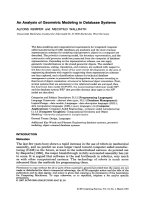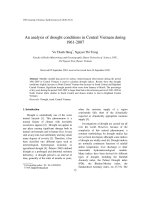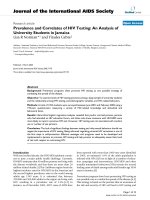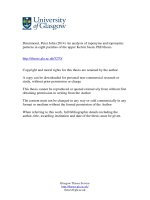An analysis of cohesive devices in writing application letters
Bạn đang xem bản rút gọn của tài liệu. Xem và tải ngay bản đầy đủ của tài liệu tại đây (560.76 KB, 77 trang )
BỘ GIÁO DỤC VÀ ĐÀO TẠO
TRƯỜNG ĐẠI HỌC DÂN LẬP HẢI PHÒNG
-------------------------------
ISO 9001 : 200
KHÓA LUẬN TỐT NGHIỆP
NGÀNH: NGOẠI NGỮ
HẢI PHÒNG - 2010
1
HAIPHONG PRIVATE UNIVESITY
FOREIGN LANGUAGES DEPARTMENT
-----------------------------------
GRADUATION PAPER
AN ANALYSIS OF COHESIVE DEVICES IN
WRITING APPLICATION LETTERS
By:
VU THI THU TRANG
Class:
NA 1004
Supervisor:
NGUYEN THI THU HUYEN, M.A
HAI PHONG - 2010
2
BỘ GIÁO DỤC VÀ ĐÀO TẠO
TRƯỜNG ĐẠI HỌC DÂN LẬP HẢI PHÒNG
--------------------------------------
NHIỆM VỤ ĐỀ TÀI TỐT NGHIỆP
Sinh viên: ............................................................Mã số:....................
Lớp: .............................Ngành:............................................................
Tên đề tài: .........................................................................................
3
Nhiệm vụ đề tài
1. Nội dung và các yêu cầu cần giải quyết trong nhiệm vụ đề tài tốt
nghiệp
( về lý luận, thực tiễn, các số liệu cần tính toán và các bản vẽ).
……………………………………………………………………………..
……………………………………………………………………………..
……………………………………………………………………………..
……………………………………………………………………………..
……………………………………………………………………………..
……………………………………………………………………………..
……………………………………………………………………………..
……………………………………………………………………………..
2. Các số liệu cần thiết để thiết kế, tính toán.
……………………………………………………………………………..
……………………………………………………………………………..
……………………………………………………………………………..
……………………………………………………………………………..
……………………………………………………………………………..
……………………………………………………………………………..
……………………………………………………………………………..
……………………………………………………………………………..
3. Địa điểm thực tập tốt nghiệp.
……………………………………………………………………………..
……………………………………………………………………………..
……………………………………………………………………………..
4
CÁN BỘ HƯỚNG DẪN ĐỀ TÀI
Người hướng dẫn thứ nhất:
Họ và tên: .............................................................................................
Học hàm, học vị: ...................................................................................
Cơ quan công tác:.................................................................................
Nội dung hướng dẫn:............................................................................
Người hướng dẫn thứ hai:
Họ và tên:.............................................................................................
Học hàm, học vị:...................................................................................
Cơ quan công tác:.................................................................................
Nội dung hướng dẫn:............................................................................
Đề tài tốt nghiệp được giao ngày 12 tháng 04 năm 2010
Yêu cầu phải hoàn thành xong trước ngày 10 tháng 07 năm 2010
Đã nhận nhiệm vụ ĐTTN
Đã giao nhiệm vụ ĐTTN
Người hướng dẫn
Sinh viên
Hải Phòng, ngày tháng năm 2010
HIỆU TRƯỞNG
GS.TS.NGƯT Trần Hữu Nghị
5
PHẦN NHẬN XÉT TÓM TẮT CỦA CÁN BỘ HƯỚNG DẪN
1. Tinh thần thái độ của sinh viên trong quá trình làm đề tài tốt
nghiệp:
……………………………………………………………………………..
……………………………………………………………………………..
……………………………………………………………………………..
……………………………………………………………………………..
……………………………………………………………………………..
……………………………………………………………………………..
……………………………………………………………………………..
2. Đánh giá chất lượng của khóa luận (so với nội dung yêu cầu đã đề
ra trong nhiệm vụ Đ.T. T.N trên các mặt lý luận, thực tiễn, tính toán
số liệu…):
……………………………………………………………………………..
……………………………………………………………………………..
……………………………………………………………………………..
……………………………………………………………………………..
……………………………………………………………………………..
……………………………………………………………………………..
……………………………………………………………………………..
……………………………………………………………………………..
3. Cho điểm của cán bộ hướng dẫn (ghi bằng cả số và chữ):
……………………………………………………………………………..
……………………………………………………………………………..
……………………………………………………………………………..
Hải Phòng, ngày ….. tháng ..… năm 2010
Cán bộ hướng dẫn
(họ tên và chữ ký)
6
NHẬN XÉT ĐÁNH GIÁ
CỦA NGƯỜI CHẤM PHẢN BIỆN ĐỀ TÀI TỐT NGHIỆP
1. Đánh giá chất lượng đề tài tốt nghiệp về các mặt thu thập và phân tích tài
liệu, số liệu ban đầu, giá trị lí luận và thực tiễn của đề tài.
2. Cho điểm của người chấm phản biện :
(Điểm ghi bằng số và chữ)
Ngày.......... tháng......... năm 2010
Người chấm phản biện
7
ACKNOWLEDGEMENT
Sincerely, I would like to show my deep gratitude to many people for their
enthusiasm and helpfulness to me in preparing and completing the
graduation paper
Firstly, I would like to express my sincere thanks to Ms. Nguyen Thi Thu
Huyen, M.A, the supervisor, who enthusiastically gave me guidance and
correction for my research.
Secondly, I am so grateful to all the teachers at Hai Phong Private
University for their previous supportive lectures that helped me much
during graduation time.
Thirdly, I wish to take this opportunity to thank my parents for whatever
they support and encourage me both mentally and physically during my
studies.
Finally, I highly appreciate all the comments from my friends, who have
given me uninterrupted support by means of suggestions and corrections
during my struggle for perfection of this paper of mine.
8
TABLE OF CONTENTS
PART I: INTRODUCTION .......................................................................... 1
1. Rationale ..................................................................................................... 1
2. Aims of the study ........................................................................................ 1
3. Methods of the study .................................................................................. 2
4. Scope of the study ....................................................................................... 2
5. Design of the study ..................................................................................... 2
PART II: DEVELOPMENT ........................................................................... 3
Chapter 1: Theoretical Background ............................................................... 3
1. An overview of Business Letters ................................................................. 3
1.1.The Business Letters format ............................................................ 4
Sample of business letter format ...................................................... 5
1.2.Several types of Business Letter ...................................................... 6
2. Cohesion..................................................................................................... 16
2.1.The concept of Cohesion ............................................................... 16
2.2. Cohesion vs Coherence ................................................................ 16
2.3. Types of Cohesion ........................................................................ 16
2.4. Grammatical Cohesion ................................................................. 18
2.5 Lexical Cohesion ........................................................................... 19
2.6. Cohesive Devices.......................................................................... 20
Chapter 2: An analysis of cohesive devices in writing application
letters.
1. Application Letters .................................................................................... 26
1.1. Definition ...................................................................................... 26
1.2. Some characteristics of Application Letters ................................. 26
1.3. Letter format.................................................................................. 27
1.4. Types of Application Letters......................................................... 30
1.4.1. Solicited Letter .................................................... 30
1.4.2. Unsolicited Letter ................................................ 31
2. Structure of Application Letter ........................................................ 34
9
2.1. Kinds of sentences ............................................................... 34
2.2. Length of sentences ............................................................. 34
2.3. Paragraphs............................................................................ 34
2.4. Sentence order ..................................................................... 35
2.5. Vocabulary........................................................................... 35
2.6. Tense, aspect and mood ....................................................... 35
2.7. Voice .................................................................................... 36
2.8. Modal Makers ...................................................................... 36
3. Grammatical Cohesion in English Application Letters ................... 37
3.1. Reference markers ............................................................... 37
3.2. Substitution .......................................................................... 39
3.3. Conjunctions ........................................................................ 40
4. Lexical Cohesion ............................................................................. 41
4.1. The class of “General Nouns”.............................................. 41
4.2. The element of cohesive devices ......................................... 42
Chapter 3: Suggestions for improving application letter writing
1. Application letters ........................................................................... 45
1.1. The characteristics of application letters in English ... 45
1.2. Cohesion in English Application letters .................... 46
1.2.1. Grammatical Cohesion .................................46
1.2.2. Lexical Cohesion ........................................ 47
1.3. Suggestions for application letter writing.......................... 47
PART III: CONCLUSION ................................................................................49
References .......................................................................................................... 50
Appendixes .......................................................................................................... 51
10
LIST OF TABLES AND FIGUES
Pages
Figure 1: Sample of Business Letter format
5
Figure 2: Sales letter
7
Figure 3: Inquiries letter
9
Figure 4: Order letter
11
Figure 5: Complaint letter
13
Figure 6: Refusal letter
15
Figure7 : Conventionalized Format and Style of an
29
Application Letter
Figure 8: Solicited letter of application
30
Figure 9: Advertisement of Employment
31
Figure 10: Unsolicited letter of application.
33
Table 1: Type of Cohesion
17
Table 2: Grammatical and lexical Cohesion
17
Table 3: Personal reference in AL
37
Table 4: Demonstrative reference in AL
38
Table 5: Comparative reference in AL
39
Table 6: Conjunctive relations in Application Letter
40
11
PART I: INTRODUCTION
1.
Rationale
Business letters are one of the ways for any business to communicate
with all of its stake holders. These stake holders may include customers,
suppliers, employees, shareholders, management, government and the
public in general. There are many types of business letters in use.
Application letter is a special kind of business letter. Of all the different
kinds of letter, perhaps none is more important for one‟s personal career
than those letters he writes to apply for a job. Especially, application letter
becomes more and more important in the current global situation.
As I see it, there is a need for young people graduating from
universities to be prepared for job and future that the majority of the
students can master. With application letter, I wish to stress the importance
of cohesive devices in writing and realize the role and contribution of
cohesive devices to successful application letter. Moreover, cohesive
devices can make application letter which is clearer and more logical.
Basing on the above facts and other acquired information I made the
decision to study more in detail about cohesive devices in writing
application letters for my graduation paper, hoping that it can help me and
other learners understand and practice it properly in our future working life.
2.
Aims of the study
This subject is to improve the using cohesive devices in writing
application letters properly by:
- Analyzing words, phrases and some cohesive devices in writing
application letters.
- Discussing some possible problems occurring in writing
application letters such as: presenting without a purpose, not informing
enough detailed information for company...
- Giving suggestions to get an effective writing application letters.
12
3. Methods of the study
The combinations of quantitative and qualitative approaches are applied:
- To search for what the cohesive devices in application letter are.
- Then to work out the links how such cohesive devices can help to
improve the application letter writing.
I have collected theories from another sources, from reference books,
websites, sample application letters sent to international companies by both
English speakers and Vietnamese.
The data are described in the form of figures and then analyzed by data
transforming. Attention is focused on the frequency of cohesive devices
usage in application letters.
4. Scope of the study
The study focus on the analysis 15 collected application letters sent to
international organizations or companies abroad or in Vietnam. The other
types of cohesive devices listed into grammatical and lexical cohesion are
focused in the paper.
5. Design of the study
The study is divided into 3 main parts:
- The first part is the introduction which gives out the reason for
choosing the topic, point out the aims of the study, the scope of the study as
well as the methods applied.
- The second part is the development which consists of three chapters
1. The first chapter deals with the theoretical background which
provides readers with the knowledge of business letter, cohesive devices in
writing business letters, application letters.
2. The second one focuses on the performance of cohesive devices.
3. The third chapter provides readers the findings and appropriate
suggestion in using cohesive devices properly in application writing.
13
- The last part is the conclusion of the study. All the information from
the previous parts of the study is summarized in this part and some
suggestions are offered for further study.
PART II: DEVELOPMENT
CHAPTER I: THEORETICAL BACKGROUND
1. An overview of business letters.
1.1.The business letters format.
Bertha J. Naterop (1978) considered: “Business Letters is intended
for students of commerce, for all those people working in business, and for
those in other walks of life too. It is clear that an executive, a department
manager, a salesman, a secretary or a specialist in business and technology
has to write English letters, but also many people will want to buy
something abroad, accept an invitation, or congratulate a friend in
English.”
14
The business letter format.
1. The printed letter Includes name, address, telephone number of the sender, and may
head
contain a description of the business, trade-mark, telegraphic
address, telex, etc.
2. Reference
Initials, number or both. Addressee‟s reference, where known, is
typed first.
3. Date line
Abbreviations may be used for Jan, Feb, Aug, Sept, Oct, Nov, Dec
but do not write the month in figures. No mention of town.
4. Inside address
The inside address is the recipient‟s full name and address. The
inside address should be flush with the left margin - and the left
margin should be at least one inch wide. Include the reader‟s full
name and title and his or her full address, including ZIP code.
5. Attention line
May also be omitted.
6. Salutation
Starts with a capital letter and is usually followed by a comma.
7. Subject line
May also be omitted.
8. Body of letter
The body of the letter is, of course, what the letter is about. Begin
the body two spaces below the salutation. Single-space within
paragraphs and double-space between paragraphs.
9. Complimentary close
Start the complimentary close or conventional “goodbye” a double
space below the body. Use a standard expression such as yours
truly, sincerely yours, or Re-spitefully yours. Only the first word of
the complimentary close is capitalized, and the ex- precision is
followed by a comma. Two double spaces below the complimentary
close, and aligned at the left with the close, type your full name. On
the next line, key in your business title if it is appropriate to do so.
10. Signature
Sign your name in the space between the complimentary close and
15
your typed name.
11. Enclosure
(if any)
1. The printed letter head
MATTHEWS & WILSON
Ladies‟s Clothing
421 Michigan Avenue
Chicago, III. 60602
2. Reference
Your ref: LE/N
Our ref: HCD/RP
October 21, 2005
3. Date line
4. Inside address
Messrs Grant & Clarkson
148 Mortimer Street
London WIC 37D
England
5. Attention line
6. Salutation
7. Subject line
8. Body of letter
Attention: Mr. P. James
Dear sir,
Swinger import
We saw your women‟s dresses and suits at the London Fashion Show held in
New York on October 17. The lines you showed for teenagers, the „Swinger‟
dresses and trouser suits, would be most suitable for our market.
Would you kindly send us your quotation for spring and summer clothing
that you could supply to us by the end of January next? We would require
2,000 dresses and suits in each of the sizes 10-14, and 500 in sizes 8 and 16.
Please quote c.i.f Chicago prices. Payment is normally made by letter of
credit.
Thank you for an early reply.
9. Complimentary close
10. Signature
Very truly yours,
P. Wilson, Jr
P. Wilson, Jr.
Buyer.
11. Enclosure
16
Enc.
Figure 1: Sample of Business Letter format
1.2.Several types of business letters.
According to “Walter E. Oliu & etal. 1998. How to write effective on
the job. Matin‟s Press”, there are almost as many types of business letters
as there are reasons for writing. That is why it is important to study the
principles discussed and apply them to both the situations are so common
that standard approaches have been developed. There are: “sales letter,
inquiries letter, order letter, complaint letter, refusal letter ...”
Sales letter: Direct advertising, in the form of letters to a
selected group of readers, is an effective way to promote sales. Such sales
letters should appeal to the potential customer. They should:
- Arouse the reader‟s attention.
- Create desire to make use of your offer.
- Convince him that these products or services are the best
ones for him.
- Activate him to place an order.
Almost any communication can be used as a sales letter.
Announcement to customers and others or important charges can be used to
make your company, your products or services better known to the public,
and to attract buyers.
17
FARMERS FRUIT PRODUCTS
Taunton, Somerset
England
Mr. Loretta Vasquez
1402 Broadway
Sacramento, California 91400
November 2007
Dear sirs,
Attract
reader’s In the field of fruit preserves, English jams and marmalades have been
interest
regarded as the best for a century and a half. Competition has not affected
their quality or attraction. Their reputation is spread by everyone who tastes
them: they are recommended by word of mouth to relatives, friends and
many prospective customers.
Convince the quality English fruit farmers supply FARMERS with the best quality produce from
of product
their orchards and gardens. Fresh citrus fruits are imported from Spain and
Israel all the year round. Careful selection and preserving ensure the quality
of the well-known FARMERS jams and marmalades that are supplied to
stores all over the world in 1 lb jars or 2 lb tins.
Activate the placing Please refer to the enclosed price-list, and let us know your requirements on
an order
the form attached. You may be able to profit from special terms on your
initial order. Delivery can be made shortly after we receive your order.
FARMERS look forward to hearing from you soon.
Yours faithfully,
FARMERS FRUIT PRODUCTS
Enc. Price-list
Provisional order form.
Figure 2: Sales letter
18
Inquiries letter: An inquiry (also spelt enquiry) is sent when
a business wants some information, especially about:
- The supply of goods
- Availability of goods
- Leaflets or catalogues
- Delivery times and deadlines
- Quotation or prices
- Method of transport
- Samples
- Insurance.
- Terms and discounts
He will save unnecessary correspondence by giving full details
that are relevant. If a prospective customer approaches supplies for the first
time, it is useful to tell them something about his own business, the kind of
goods he needs and for what purpose they are required. In the case of
customers of long standing or repeat orders, the inquiry may be very simple.
Often a phone call or a post-card will do.
19
Mahoney and Millman, Inc.
1951 Benson Street
Bronx, New York 10465
RBM Manufacturing Company, Inc.
New York, New York 10
May 2, 2008
Dear Sir or Madam,
Inquiry
We intend to purchase a new office copier before the end of the
information
fiscal year. We would like to consider an RBM copier and
of goods
wonder if you have a model that would suit our needs.
Our office is small, and a copier would generally be used by only
Include
information
detail three secretaries. We run approximately 3,000 copies a month
and prefer a machine that uses regular paper. We would like a
collator, but rarely need to run off more than 25 copies at any
one times.
Inquiry
warranty
for We would also like to know about your warranty and repair
service.
Since our fiscal year ends June 30, 2008, we hope to hear from
you soon.
Sincerely yours,
William Wilson
William Wilson
Office Manager.
WW/sw.
Figure 3: Inquiries letter
20
Order letter: In comparison to the correspondence so far,
placing an order is simple from the point of view of letter-writing. Very
often the purchasing department or the buyer fills in an order form,
although he may prefer to write a letter to make certain points quite clear.
There could be special import regulations which make it necessary to
complete formalities, or he may want to stress delivery instructions or
other matters.
Make sure that the order letter contains the following information,
as it applies to the items or items you are purchasing.
- The exact name and part number of the item.
- Any useful description of the item: size, style, color...
- The quantity needed of each item.
- The price of the item.
- The shipping method.
- The date of the order and the date by which you need
the item.
- The exact and full shipping address.
-
The method payment.
21
250 Commonwealth Avenue
Boston, Massachusetts 02118
Cape Cod Ornaments, Inc.
94 State Road
West Yarmouth, Massachusetts 02757
February 14, 2007
Dear Sir or Madam,
Name part of item
I have seen your ad in the Boston Globe of Sunday, February
12, and would like to order the following weather vane:
Description quantity, Model EPC-18‟‟ eagle with arrow, copper, $34.95.
price needed.
Method of payment
I would like the weather vane sent to the above address by
parcel post and charged, with any applicable sales tax and
handing costs, to my VISA account (number 003 0971 A109;
expiration date, 3/93).
Your truly,
George Mapenzi
George Mapenzi
Figure 4: Order letter
22
Complaint letter: Mistakes may occur in day-to-day
business, and these give cause for complaint. There might have been a
misunderstanding about the goods to be supplied; perhaps the ware house
clerk made an error in addressing the parcels; sometimes a consignment is
dispatched too late or delays are caused in transit; damage may have
occurred during delivery; a manufacturing defect is discovered when a
machine is used.
The customer is understandably annoyed, yet this is no reason to
write an angry letter of complain. His company may take mistakes too:
firms often have to manage with insufficiently trained personnel or to
contend with a staff shortage, so mistakes and accidents happen.
23
21 West Main Street
Cochecton, NY 11222
Dr. Linda Peters, Director
County General Hospital
Callicoon, NY 11203
October 9, 2009
Dear Dr. Peters,
Indentity fault
On the afternoon of October 8, my neighbor‟s son, Kevin Sawyer,
was raking leavens in his family‟s yard when he tripped and fell. I
suspected he might have broken his ankle. Thus, as the only adult
around at the time, I drove him to your hospital.
Explain problem
When we arrived at the emergency room, and I had to help him
hobble in as best I could. The effort increased his pain, yet when
we were inside, the receptionist, without looking up, told us to take
a number and wait our turn. We waited for more than two hours
before Kevin was seen by a doctor.
Expect solution to As a member of the community your hospital serves, I am outraged
your satisfaction
by the treatment my young neighbor received. The lack of concern
was upsetting; the lack of attention could have been life
threatening. All of us in Wayne county deserve better treatment,
and I hope you will look into the situation to see that the suffering
caused by Kevin Sawyer is never again inflicted by an employee of
your institution.
Yours truly,
Michelle Sussman
Michelle Sussman
Figure 5: Complaint letter
24
Refusal letter: When you receive any letters (complaint letter or
an inquiry letter) to which you must give a negative reply you may need to
write a refusal letter. It is very difficult to write because it contains bad
news. However, you can convey the news tactfully and courteously.
In your letter, you should lead up to the refusal. To state the bad news in
your opening would certainly affect your reader negatively. The ideal
refusal letter says no in such a way that you not only avoid antagonizing
your reader but also maintain goodwill. To achieve such an objective, you
must convince your reader that your refusal is justified before refusing.
25









